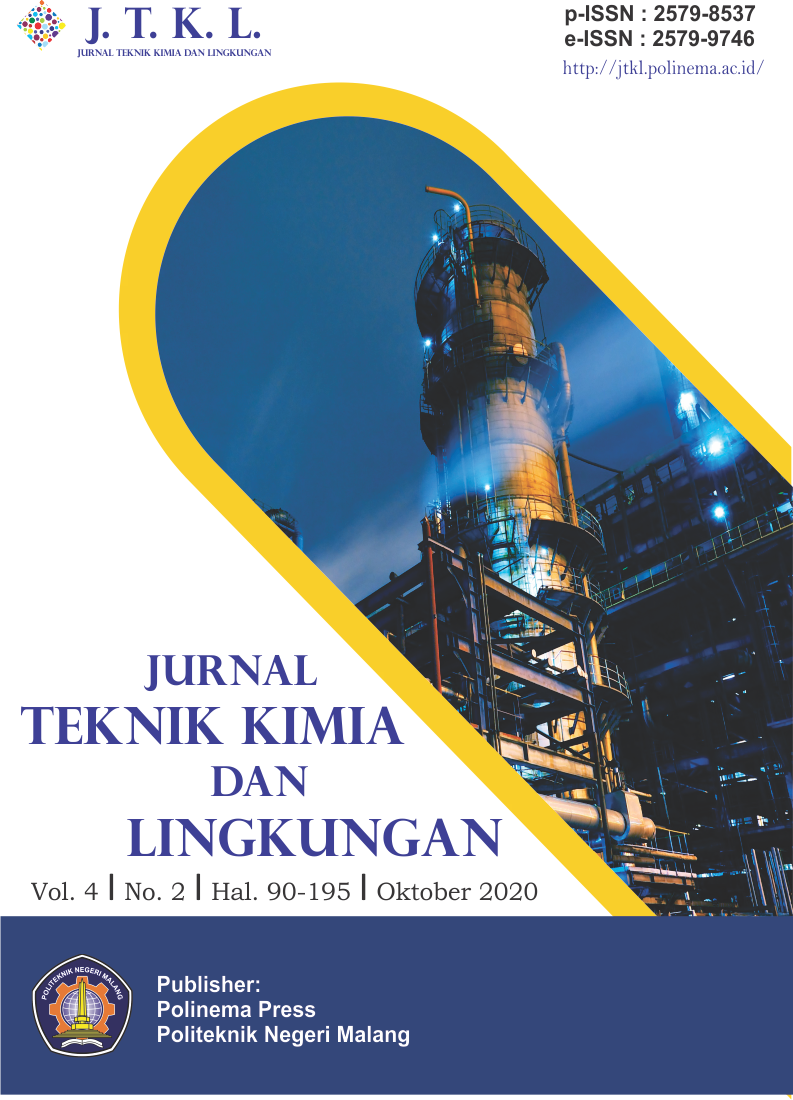Pemodelan Kesetimbangan Massa pada Keadaan Tunak (Steady) sebagai Penentuan Konsentrasi Optimum Tawas (Alumunium Sulfate) pada Proses Penurunan Kadar Fe pada Sumber Air Tercemar
DOI:
https://doi.org/10.33795/jtkl.v4i2.136Keywords:
alumunium sulfate ferric, reduction of Fe content, alumAbstract
Air tanah merupakan andalan sumber mata air bagi masyarakat pada umumnya, beberapa sumber air tanah sering dijumpai air yang masih terkandung Fe, hal tersebut berdampak buruk bagi kesehatan oleh karena itu perlu dilakukan penuruan kadar Fe pada air sebelum digunakan. Beberapa metode yang umum dilakukan untuk menghilangkan kandungan Fe pada air adalah dengan cara koagulasi oleh tawas. Penelitian ini akan memodelkan sebuah persamaan matematika yang dapat mengkuantifikasi penurunan kadar Fe pada setiap fungsi kosentrasi tawas yang ditambahkan. Model matematika pada penelitian menggunakan penurunan rumus dari kesetimbangan masa. Dari hasil perbandingan data percobaan dengan data perhitungan didapat konstanta penurunan Fe (kF) pada fungsi konsentrasi tawas sebesar 1.8/mg tawas dan nilai konstanta R2 sebesar 0.935, dari data tersebut maka model matematika yang dibuat dapat mewakili fenomena proses penurunan Fe di lapangan.
In general groundwater is relied as source water but somtimes we found precense of Fe in some of groundwater products that could harm our health due to its toxicity, therefore it is necessary to reduce Fe content as pretreatment process. Some common methods to reduce Fe content in water are coagulation by alum. This study will build a mathematical equation to quantify the reduction of Fe content in function of alum concentration. In this study the equations were derive from mass balance equation. By comparing the experimental data with calculated data, we obtained kF (The constant of consuming Fe) = 1.8 / mg alum and for R2 constant we obtained 0.935, from these result we conclude our derived equation can represent the phenomenon of alum-Fe reduction phenomena in the field.
References
M. Kumar, A. Puri, A review of permissible limits of drinking water, Indian J. Occup. Environ. Med., vol. 16, no. 1. hal. 40–44, 2012.
B. Gassmann, Requirements of Vitamin A, Iron, Folate and Vitamin B12. Report of Joint FAO/WHO Expert Consultation. 107 Seiten, 5 Abb., 24 Tab. Food and Agriculture Organization of the United Nations; Rome 1988., Nahrung, 1991.
Permenkes No. 492/Th.2010, Persyaratan Kualitas Air Minum, Peraturan Menteri Kesehatan Republik Indonesia, 2010.
N. Abbaspour, R. Hurrell, R. Kelishadi, Review on iron and its importance for human health, J Res Med Sci., vol. 19, no. 2, hal. 164-174, 2014.
J. L. K. Bacon, Bruce R., Stanley L. Schrier, Treatment of hereditary hemochromatosis, artikel UpToDate, 2011.
World Health Organization, Iron in drinking-water. WHO Guidelines for drinking-water quality, Who/Sde/Wsh/03.04/08, 2003.
W. Stumm, G. F. Lee, Oxygenation of ferrous iron, Ind. Eng. Chem., vol. 53, no. 2, hal. 143-146, 1961.
E. J. Roekens, R. Van Grieken, Kinetics of iron(II) oxidation in seawater of various pH, Mar. Chem., vol. 13, no. 3, hal. 195-202, 1983.
J. M. Trapp, F. J. Millero, The oxidation of iron(II) with oxygen in NaCl brines, J. Solution Chem., vol. 36, hal. 1479-1493, 2007.
G. R. Watzlaf, K. T. Schroeder, C. L. Kairies, Modeling of iron oxidation in a passive treatment system, in: 18th Annual Meeting of the ASSMR, New Mexico, June 3-7, 2001.
B. Morgan, O. Lahav, The effect of pH on the kinetics of spontaneous Fe(II) oxidation by O2 in aqueous solution - basic principles and a simple heuristic description, Chemosphere, vol. 68, no. 11, hal. 2080-2084, 2007.
D. Sianita, I. Nurchahyati, Kajian pengolahan limbah cair industri batik, kombinasi aerob – anaerob dan penggunaan koagulan, in: Seminar Penelitian S1 Jurusan Teknik Kimia UNDIP 2009, Jurusan Teknik Kimia Universitas Diponegoro, 2009.
R. Raimon, M. Said, Laboratory effluent Treatment by using coagulant alum sulphate and poly aluminium chloride (PAC), Indones. J. Fundam. Appl. Chem., vol. 2, no. 2, hal. 47-51, 2017.
W. Jackaman, Regional stream sediment and water geochemical data; Terrace & Prince Rupert (NTS 103I & 103J), British Columbia, Geosci. bc Rep., 2008.
C. Watson, How to Calculate R2 Excel, 11-09-2019. [Online]. Available:www.techwalla.com/articles/how-to-calculate-r2-excel.
Downloads
Published
Issue
Section
License
Copyright (c) 2023 Alfiana Adhitasari, Eko Andrijanto

This work is licensed under a Creative Commons Attribution-NonCommercial 4.0 International License.







